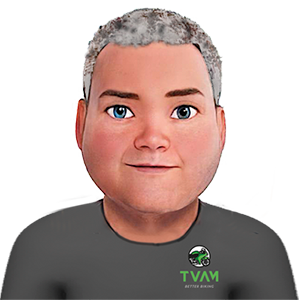It was great to see the photographs, the article by Brian Walmsley and the quotes from the attendees of the infamous 7Ws in last month’s Slipstream. After being postponed multiple times due to COVID, it’s great to see the fun had by so many.
I was lucky enough to spend the last weekend in October as a guest at the Bournemouth & Wessex Advanced Motorcyclists observer weekend. North Devon as some excellent and challenging roads, set in some of the most beautiful countryside. It’s fair to say that the weather wasn’t completely kind to us and the road conditions required a little extra thought as we rode throughout the two days.
As well as wet roads and the odd piece of tree branch laying in the road, riding at this time of the year means having to contend with a low sun. It’s not just the sun in your face, it can often reflect in the wet road surface, in our mirrors affecting our rear observation or piercing through the trees creating a strobe effect across our eyes. This can be distracting at best and disastrous if carrying just a little too much speed or riding close to our limit.
Other hazards to look out for are microclimates. Tree-covered roads may not fully dry out, even on a bright sunny day. Patches of mist or fog can be present when travelling close to water. Icy patches on damp surfaces that are not exposed to sunlight and on bridges where the surface temperature is often lower than the standard road surface. Understanding that these conditions exist and building them into our riding plan is all part of becoming an advanced motorcyclist.
I’m sure you have all heard the phrase, “there is no such thing as poor weather, just inappropriate clothing”. So, consider a little more what you wear on a bike in poor conditions; layer up on cold days and change that tinted visor for a clear one, perhaps with a pinlock or similar anti-fog system on your visor.
Shorter days often mean that we are having to ride in poor light or complete darkness. There is a great article in the latest IAM RoadSmart magazine, specifically about driving and riding at night. A range of specialists give their top tips on driving and riding in the dark, with Rhys Hughes, Head of Driver Training for Avon & Somerset Constabulary chosen to speak about motorcycling. He advises how riding at night can be relaxing, warning about not getting lulled into a false sense of security on those nice quiet roads. Further views from an ambulance crew, a highway maintenance worker, a Royal Airforce driver and a racing driver negotiating the Mulsanne straight at 170mph at Le Mans is certainly worth a read. Understanding other people’s views can massively improve on our own knowledge.
And that’s the point really. As advanced motorcyclists we have a responsibility to continuously improve our knowledge base. The advanced Rider Course (ARC) book has a section on riding in inclement weather and riding at night in the appendices. If you don’t want to ride in the wet, low sun or at night-time, consider broadening your knowledge so that you can do it if you need to.
Finally, many of us choose to ride all year round and there are many things that the Club continues to offer during the winter months. However, if you prefer to lay your bike up for the winter, then maybe take a look at the article by Andy Slater in the December edition of Slipstream 2020. There’s some great practical advice on how to prepare your bike for winter storage to ensure that it’s in great condition when it comes out of hibernation next spring. You can find copies of Slipstream in the All Members Section of Groups.io, under the files tab on the left-hand side.
Have fun and stay safe everyone.
Barrie Smith
Chairman




